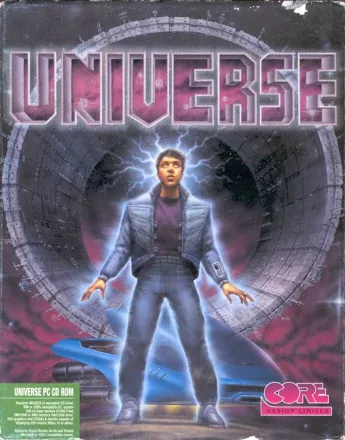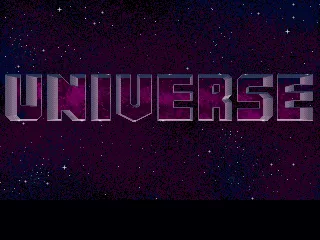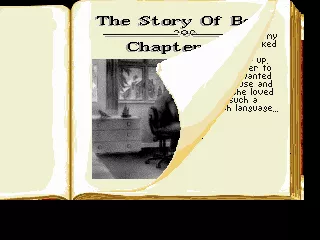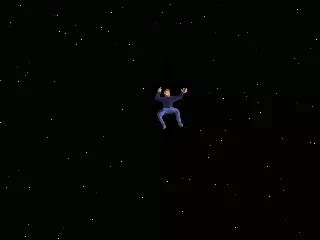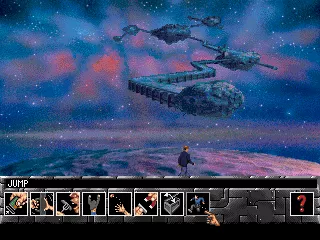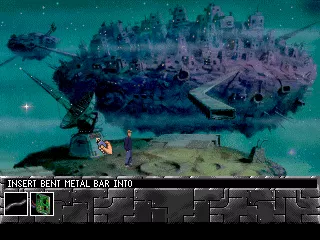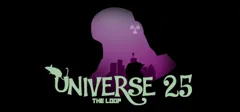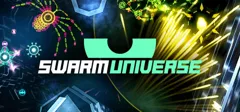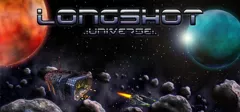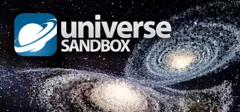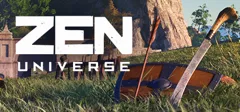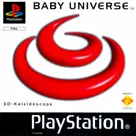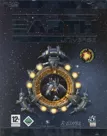Universe
-
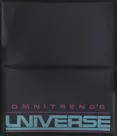 Universe
(1983 on
Atari 8-bit, 1984 on
Apple II, 1987 on
DOS)
Universe
(1983 on
Atari 8-bit, 1984 on
Apple II, 1987 on
DOS)
Description
You are Boris Verne, a normal guy who has been cast in a parallel universe because of your uncle's Virtual Dimension Inducer. There you'll have to find the fabled lost star as well as a way to defeat the Golden King... This is a classic old-style adventure game with a point & click interface. It uses the Rotoscope system to manage game characters and scores really beautiful 256-colour graphic.
Screenshots
Credits (DOS version)
17 People (14 developers, 3 thanks) · View all
| Producer | |
| Additional ideas | |
| Sprites artist | |
| Game design | |
| In-game text | |
| Manual | |
| Music | |
| Background artist | |
| Original game idea | |
| Additional game text | |
| Additional manual text | |
| Box cover | |
| Play-testers | |
| Help with manual | |
| P.C. Conversion |
|
| Programmer | |
| Music | |
| Thanks | |
| [ full credits ] | |
Reviews
Critics
Average score: 66% (based on 22 ratings)
Players
Average score: 3.8 out of 5 (based on 26 ratings with 2 reviews)
Great graphics but puzzles with no mercy
The Good
The graphics! They're really great. You can see that they painted them in real and scanned them into the game.
It looks really great and it creates a good atmosphere.
The Bad
The puzzles are a little annoying, because you can act too much in the game. You can not only "use" a smartcard with a terminal, you can "put it in".
Also you would normally "use" 2 things with each other but thats wrong!
You must "combine" them. So when you have the right idea to use 2 things with each other, you must try with some options till it works.
That's annoying.
In some cases I had the right idea to use 2 things, but when I saw in a walkthrough my idea was right, but I tried with the wrong action.
The objects are sometimes so small that you can´t see them. There are no tooltips or any help to find objects in the screen. The only way to find them is simply to click the entire screen down and hope to find something. The Interface is really awful.
Also the story of the game is not very original. It's a normal story without new impulses. A boy who gets into a "strange" dimension (aliens look really human!), a beautiful girl and a real bad Dictator. Nothing new.
The Bottom Line
A good game with great graphics and a lame story.
The puzzles are really frustrating because of the awful interface and the gameplay without mercy.
A game for real adventure fans, but nothing for beginners!
DOS · by chromax (179) · 2003
The Good
Universe is Core Design's second adventure game after Curse of Enchantia. In the game, a young boy, Boris Verne, is asked by his Mom to deliver some mail to his Uncle George. While he is giving the mail to him, he notices some flashing lights behind a door at the end of the hallway, and being curious, he decides to investigate, only to find that it is a machine known as the Virtual Dimension Inducer. Boris uses the Inducer and accidentally transports himself on top of a planetoid somewhere in another universe. He eventually realizes that he can't find a way home until he settles a dispute between the Mekalien and the Virgan Empires.
The game have some good graphics in it. You see, while you are playing the game, you will notice that each scene is a work of art. When you explore your surroundings right at the beginning of the game, you will see how much detail really went into creating the space atmosphere, as well as the stars, asteroids, planetoids, and clusters that are within that atmosphere. Later in the game, you manage to steal a PTV (Personal Transport Vehicle) which you use to navigate between planets, and the interior of the PTV is well drawn, and look like one that is used in many sci-fi movies. The map in which you select a planet to navigate is grid-referenced, and looks similar to the one in street directories, despite the black background that it uses.
And you cannot travel to each planet on the map. The ones you can travel to, however, have an atmosphere and landscape that determine the severity of that planet. Two planets called Coros and the Wheelworld have atmospheres that look futuristic enough, particularly Coros, where the atmosphere has a pinkish-red feel to it. Some structures in the game look very good. There is a crawler on Ankarlon 5 that is worth looking at, and looks like it is in 3D. Speaking of 3D, the game features a lot of rotoscoping, but apart from the crawler, I was too busy with the game to notice the feature.
Unlike COE, there is some arcade sequences, similar to the ones in those games from Dynamix, that you have to play in order to complete the game. Some of these sequences are easy, while some are hard. The object of these sequences is to move your PTV to a particular spot, or use it to fire at intruders. On one of the planets, you get to play a good game called Invaders, which features the same plot as the original, but features stupid-looking characters.
The music is played through the Sound Blaster, and the music that plays in certain scene sounds excellent. When you are in a situation where someone is chasing you, some fast music is heard. During the arcade sequences, as well as the finale, high-impact music is heard.
The Bad
Unfortunately, Universe doesn't have any sound effects, so I had to imagine what the effects would sound like. I don't know if there are sound effects in the Amiga version.
The game uses too much text, which I found hard to follow sometimes. I can think of a number of scenes that could have been cut-scenes and do away with the text. The introduction is an example.
The same problem with COE is found in Universe. You perform actions by clicking far too many icons, even though the icons themselves have some text that tells you what function that they have.
The Bottom Line
Universe is a great game, with superb music and graphics. If you like games with a space-theme, then I would suggest giving the game a try. I do not know if Universe was also released on CD-ROM with full speech, but if it has, then I missed out on it.
Rating: ****½
DOS · by Katakis | カタキス (43085) · 2005
Trivia
256 colour graphics on Amiga
Amiga 500/600 equipped with OCS/ECS chipset was able to use at once only 32 colours on a screen or 64 colours on a screen in an extra half bright mode using 32 colours and their 32 shades. Developers of Universe managed to obtain 256 colours on A500/600 using custom made mode called S.P.A.C. - Super Pre-Adjusted Colours. In some way it was a trick. Rolf Mohr airbrushed the pictures and then scanned them into a PC at 256 colours. Gary Antcliffe came up with a method where he could use the Copper co-processor to change up to 16 colours every raster line so there could be up to 256 colours on a standard A500. The game ran in extra half-brite mode so those 16 colour changes actually gave you 32 colours due to how half-brite mode worked. There were some issues as you’d lose some details in places and developers had to have some fixed colours for the main character and background animations. However, none of the screens consisted of 256 different colours. The largest number was close to around 240. (source: Arcade Attack)
The name of the mode was invented by Rolf Mohr. It was explained in The One magazine (January 1994 issue):
Because the Amiga version of Universe has up to 256 colors on screen, I (programmer) had to develop an utility that allowed you to do this. The only problem is that the Amiga doesn't have 256 shades, so when you take the screen from the PC and convert it to the standard Amiga you lose some of those shades. Our artist kept saying that it kept 'spacing' our pictures, hence it was christened SPAC mode. Rolf Mohr (Background GFX artist) did come up with an acronym for it: Super Pre-Adjusted Colour. It was nothing to do with me, though, I just wrote the program.
PC conversion hidden messages
In the installer program code of the PC CD conversion, there are some remains of the test tools, plus a message from the programmer, seemingly getting very tired of this work.
Quote:
YET ANOTHER SCROLLER FROM THAT WONDERFUL PERSON NEIL BERESFORD, SO HOLD ON TO YOUR HATS. MANY MANY THANKS GO TO THE FOLLOWING PEOPLE ....
ME ( COZ I WROTE THIS WORK OF ART, YOU KNOW, FROM THE ASHES OF THE AMIGA AND ALL THAT ) , MARTIN 'WHO LOVES YE BABY !!' COOK, MARK ' STOP USING LALA AS A LABEL !!' STAMPS, PAUL 'CAN WE GO TO THE BANK TODAY ?' BLYTH .... OH THE LIST GOES ON AND ON, SOD THE LOT OF YOU
STORY TIME .... IT ALL HAPPENED WHEN I WAS 8, YOU KNOW, EVEN THEN I HAD AN IQ OF OVER 200, WELL THATS ANOTHER STORY. WELL, BACK TO THE PLOT.. OH DID I TELL YOU THIS IS A TRUE STORY, NO.. OH WELL IT IS ... OH YEA, WELL WITH AN IQ OF OVER 500, I HAD LOTS OF PROBLEMS MIXING WITH PEOPLE MY AGE, SO I MADE THIS VOID, WHERE NOTHING HAPPENED, AND I SAT IN IT. THE NEXT THING I KNOW, I HAVE AGED TO 29, AND SOME THIEVING B**TARD TOOK MY FUCKING IQ, AND HE ONLY LEFT ME WITH 10 IQ BITS, SO THATS WHY I AM PROGRAMING UNIVERSE, BECAUSE NO OTHER F**KER WILL DO IT ! END OF STORY .... WASN'T THAT SAD !!! NO, WELL F**K YOU THEN !!
MILKY MILKY [ PS .. GET A LIFE, THIS IS THE PITS ...]
End quote.
Version differences
For DOS, there are no differences between the CD and the floppy version, but you can play the game directly from the CD-ROM without installing the game on your hard disk.
Awards
- Amiga Joker
- Issue 02/1995 – #3 Best Adventure in 1994 (Readers' Vote)
Analytics
Identifiers +
Contribute
Are you familiar with this game? Help document and preserve this entry in video game history! If your contribution is approved, you will earn points and be credited as a contributor.
Contributors to this Entry
Game added by Sauron.
Amiga added by POMAH. Amiga CD32 added by Martin Smith.
Additional contributors: Jeanne, Patrick Bregger, mailmanppa.
Game added September 7, 2002. Last modified January 17, 2024.


